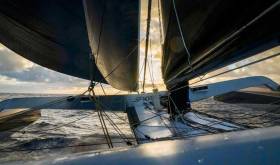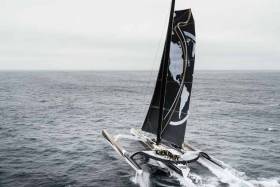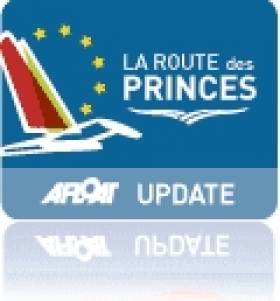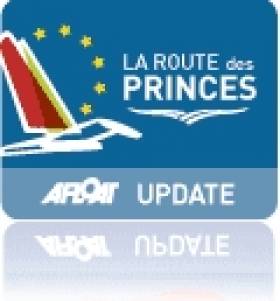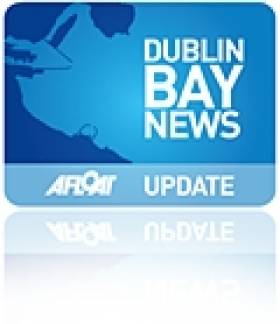Displaying items by tag: Spindrift
Spindrift Jules Verne Record Bid Underway
Yann Guichard and his crew started their world tour at Ushant on, Wednesday, January 16 at 11h 47min 27sec UTC. To win the Jules Verne Trophy they have to recross the line by February 26 at 11h 16m 57sec UTC to break the record, held since 2017 by Francis Joyon and his crew, of 40 days 23h 30m 30s.
The weather conditions were favourable at the Creac'h lighthouse, which marks one end of the start and finish line of the Jules Verne Trophy course, the round the world sailing record via the three Capes. A southwesterly breeze of 20 knots and calm seas allowed the giant black and gold trimaran to head quickly towards a front off Ushant and pick a good system from the north-west. It is these strong winds that Spindrift 2 will be able to pick up to take them quickly down to Madeira, the Canaries and the Cape Verde archipelago.
According to the routing of the team's onshore weather router, Jean-Yves Bernot, the team could reach the equator during the night of Sunday to Monday, January 21, after less than five days at sea. Once over this imaginary line between the two hemispheres, Yann Guichard and his crew must continue to speed on, with the aim of crossing the longitude at the Cape of Good Hope in about twelve days. This challenge is very possible as Francis Joyon and his crew reached the African cape in 12d 21h 22m.
By adding all the best reference times since the first attempt on the Jules Verne Trophy in 1993, the crewed world tour from Ushant to Ushant could potentially be completed in 38 days.
"the voyage from Ushant to Ushant could potentially be completed in 38 days"
The first stretch towards the equator looks very favourable, but it is still too early to anticipate what follows. If a depression moves away from Brazil during the passage off Salvador de Bahia, the weather configuration could allow the team more options to sail more directly towards the South without having to go around the St. Helena anticyclone.
Afterwards it will be the depressions to the south, their trajectories, north-south positioning and speed that will determine if the Indian Ocean can be crossed in less than 5d 21h 08m and the Pacific in less than 7d 21h 13m.
The Jules Verne Trophy:
Start and finish: a line between Creac'h lighthouse (Isle of Ushant) and Lizard Point (England)
Course: non-stop around-the-world tour travelling without outside assistance via the three capes (Good Hope, Leeuwin and Horn))
Minimum distance: 21,600 nautical miles (40,000 kilometres))
Ratification: World Sailing Speed Record Council, www.sailspeedrecords.com)
Time to beat: 40 days, 23 hours, 30 minutes and 30 seconds)
Average speed: 22,84 knots
Date of current record: January 2017
Holder: IDEC Sport, Francis Joyon and a 5-man crew
Start date for Spindrift 2: 16 January 2019 at 11h 47min 27sec UTC
More on the Spindrift 2 website here
Spindrift Set for Jules Verne Round the World Trophy Bid
Yann Guichard and his crew arrived in Brest last night to start the Jules Verne Trophy. Despite a good though not ideal weather window, after two months on stand-by Spindrift racing has decided to take its chance and will leave the dock late this morning to be at the Créac'h lighthouse in the afternoon.
The team was planning to start a week ago, but the weather further down the course did not materialise as anticipated. However, the area of depression that is currently sitting off the coast of Brittany has finally given the team the opportunity to start their challenge on the Jules Verne record. With strong conditions forecast for the start, the current files show the team reaching the equator in just over five days (5d 5h - 5d 10h), which will give them a cushion on the reference time set by Francis Joyon and his crew (5d 18h 59').
The team is aiming to catch an area of depression off the coast of Brazil to give them a quick crossing of the South Atlantic towards the Cape of Good Hope.
“We are now Code Green: the latest weather files confirm our departure from the pontoon around noon today, with a Jules Verne Trophy line crossing following quickly. The 25-30 knot wind from west to north-west will strengthen as we cross the Bay of Biscay, and we are expecting big seas with five metre waves. It looks like the first 12 hours will be hard going, but then the wind will soften off Cape Finisterre to more moderate trade winds, and we will be doing a lot of gybes towards the Canary Islands,” commented Yann Guichard as the last of the fresh food was taken onboard Spindrift 2.
The Jules Verne Trophy record has been held by IDEC Sport (Francis Joyon and his crew) since January 2017, with a time of 40 days 23 hours 30 minutes. During that challenge the team took 12 days 21 hours 22 minutes to reach the tip of South Africa, so improving this time is one of the first objectives of Yann Guichard and his eleven crew.
2018 JULES VERNE TROPHY CREW:
Yann Guichard (skipper): watch the portrait
Erwan Israël (navigator): watch the portrait
Jacques Guichard (watch captain / helm / trimmer)
Christophe Espagnon (watch captain / helm / bow)
Xavier Revil (watch captain / helm / trimmer)
François Morvan (helm / trimmer)
Antoine Carraz (helm / trimmer)
Thierry Chabagny (helm / bow)
Ewen Le Clech (helm / trimmer)
Sam Goodchild (helm / bow)
Thomas Le Breton (helm / trimmer)
Erwan Le Roux (helm / trimmer)
Router: Jean-Yves Bernot
Jules Verne Trophy Record Remains Intact But IDEC SPORT & Spindrift 2 Continue Race Against Clock
The Jules Verne Trophy record is not going to be beaten on this occasion. Small areas of low pressure and large highs spread across the Pacific and South Atlantic in particular, have dashed the hopes and ambitions of the two contenders, IDEC SPORT and Spindrift 2, in spite of their determination and hard work.
However, the sporting desire remainsto get the most out of both racing machines right up to the end of their global voyages. Aboard IDEC SPORT, after 43 days of intensive sailing, they have the same desire to sail the final 2700 miles of the theoretical route, as they had back on the first day, as they are determined to get the best time possible off Ushant.
Spindrift Statement on Dun Laoghaire Route de Prince Capsize
#rdp13 – The MOD70 Spindrift capsized on the first leg of the Route des Princes inshore races in Dun Laoghaire today as Afloat.ie reported earlier.
All crew are safe and sound, but Jacques Guichard, Yann's brother and a key member of the crew, was hurt in the accident. Both brothers were airlifted by helicopter to the hospital in Dublin, where Jacques was diagnosed with fractures to the pelvis.
Yann Guichard, the skipper of Spindrift explained the circumstances of the capsize: "We had 22 to 24 knots of wind on the start line with gusts of up to 30 knots at the lower end of the course. We were at the limit of weather conditions for our boats and it was not great for racing. All the MODs had one reef in the main and staysail. We started a bit below and behind the fleet and found ourselves slightly in a wind shadow. When our rivals had moved away we had a sudden gust literally flattened us.
"I was unable to do anything at the helm, the boat was turned over with a single blow. We let out the staysail immediately, but it was too late as it all happened in a split second. the boat was lifted onto the port float and went over. Jacques was with me in the cockpit and we found ourselves in the net ... we managed to get out and then were airlifted. The mast broke in two when Spindrift turned over. The frame of the trimaran was towed away to the port. "
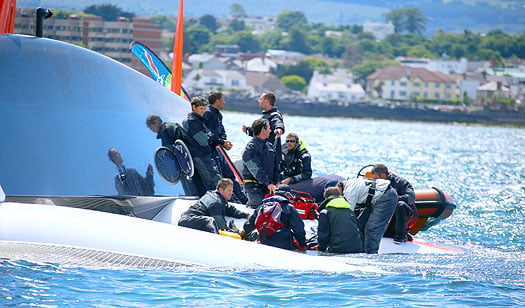
Jacques Guichard receives medical treatment prior to airlift (above) on the upturned Spindrift hull in Dublin Bay. Photo: Afloat.ie
All the crew, with the help of the whole Spindrift racing team, immediately mobilised to secure the frame and make sure the towing operation went safely. The trimaran will be returned to base in port and the Spindrift racing team will quickly and expertly assess the damage. The team will then seek a solution from the boat's home base in Saint Philibert.
#Spindrift - The race-winning multihull Spindrift has capsized in gale force winds off Dun Laoghaire this afternoon (22 June) at the start of the Route des Princes series of inshore racing spectacle on Dublin Bay, as David O'Brien reports on scene.
The MOD70 trimaran that was first into Dun Laoghaire from Lisbon on Wednesday capsized meres from spectators in Scotsman's Bay ahead of the first of three inshore races.
Rescue photos below.
The accident happened about 700 metres off the starting line in the first race, as the boats were accelerating in the strong and gusty winds. The boats were not carrying full sail as a precaution against the strong offshore winds blowing in the bay. Today's in–port racing was billed as 'fast and furious'.
At least one person is injured and is being treated upturned hull of the stricken craft. As of 3.08pm a rescue helicopter was dropping its winchman to the vessel.
It is feared by National Yacht Club personnel that the mast of the inverted trimaran is stuck in the sea bed and may be broken.
All racing has now been postponed as rescue services attended the scene. Eight crew were onboard the vessel at the time of the capsize.
Update 3.10pm: All other boats have returned to Dun Laoghaire Harbour as rescue services continue to attend to the capsized Spindrift and its crew.
Update 3.18pm: Weather conditions in Dun Laoghaire continue to be strong and gusty, and it's reported that some local DBSC RC racing had already been cancelled earlier today.
Update 3.27pm: A news update on the Route des Princes website (via @sailracewin) says one crewman on the upturned Spindrift has a back pain.
Update 3.35pm: Twitter users Mark Lloyd (@Lloyd_Images) and Philip Bromwell (@philipbromwell) have posted photos of the failed Spindrift in Dublin Bay as emergency services attend to the scene.
Update 3.39pm: The crewman casualty has been winched to the helicopter and is being airlifted to Tallaght Hospital. His condition remains unclear.
Update 3.41pm: Triage for any injured racers has been set up at the National Yacht Club and all rescue boats have been asked to report to the NYC to account for numbers.
Update 3.53pm: Assessments are currently being made as to how to recover the 70ft hull still floating north of Dalkey Island.
Update 4.04pm: Sailing journalist Kate Laven comments on Twitter re the Spindrift capsize: "Everyone recovered but two injured"
Update 4.08pm: The Route des Princes website has followed up its earlier update with a news post which confirms that weather conditions at the time of the Spindrift capsize were 20 knots with strong gusts.
Update 4.55pm: Dun Laoghaire lifeboat towing the upturned Spindrift hull (minus mast) towards Dun Laoghaire harbour
Update 6,00pm: The upturned hull has been successfully righted, the hull is intact but the mast is broken.
Update 7.00pm: There are unconfirmed reports that the injury to the Spindrift crew man is a broken pelvis.
Update 8.00pm: Spindrift racing team release statement on capsize and injury to crew member
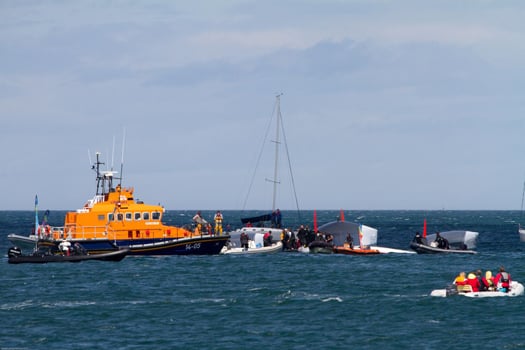
Rescue craft, local boats and the Dun Laoghaire lifeboat attend the upturned hull. Photo: Gareth Craig
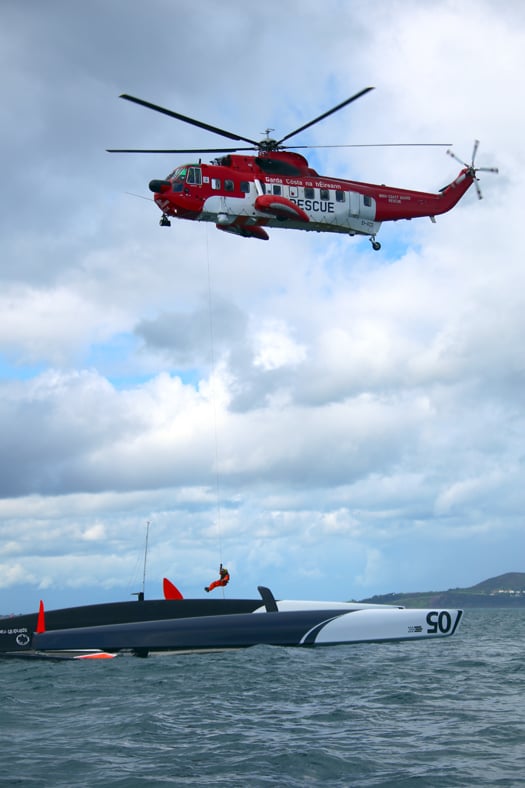
The Coastguard helicopter arrives on scene and a winch man is lowered to make an assessment. Photo: Afloat.ie
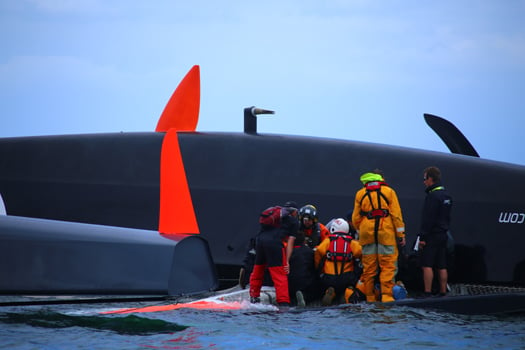
Rescue personnel and Sprindrift crew on the upturned hull in Dublin Bay this afternoon. Photo: Afloat.ie
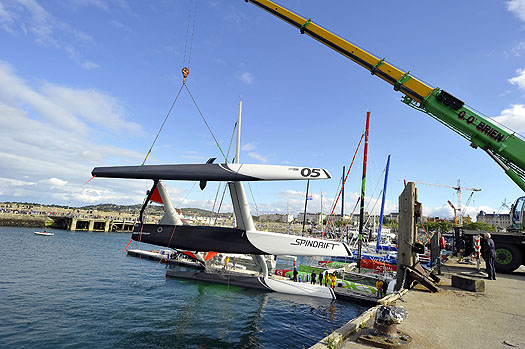
Spindrift minus her mast is lifted in Dun Laoghaire harbour this evening. Photo: Michael Chester
MOD70 is 'No Ordinary Sailing Boat'
#MOD70 - The Irish Times' Simon Tierney goes for the ride of his life on board one of the super-fast yachts sailing in Dun Laoghaire this weekend on the MOD70 European Tour.
Tierney reports from Brest in France on his "hair-raising" taster trip on the Spindrift, winner of July's Krys Ocean Race across the North Atlantic - completing the 2,950-mile route in just over four days 21 hours.
As he signs a disclaimer and straps on his helmet, he knows he's "not on an ordinary sailing boat. We will be going fast. Very fast."
The Spindrift is one of a five-boat fleet in Dublin on the first stop-over of the four-leg MOD70 European Tour that will later take in Cascais, Marseille and Genoa.
And even in the confines of Dublin Bay racing today, these multi-hull trimarans will be treating the spectators to some incredible feats of speed.
Tierney writes of his experience: "The water is furious in our wake, kicking enormous fountains into the air. I glance at the speed gauge. We are doing 35 knots. This is an extraordinary velocity for a sailing boat. It would be difficult for a speed boat to keep up with us."
As crew member Léo Lucet tells him: "Multihulls can go faster than the wind... [we can] create our own wind. That’s why we can say that the MOD 70’s are in the range of the fastest boats in the world.”
Make sure to catch the fleet in action yourself in Dun Laoghaire before they depart on the next leg to Cascais tomorrow afternoon.
The Irish Times has much more on the story HERE.


























